Sustainable Management of Food Waste during COVID-19 Pandemic: Insights into Irrational Food Hoarding among Chinese Citizens
Abstract
1. Introduction
2. Research Background and Theoretical Framework
2.1. Research Background: Food Waste Caused by IFHB during the COVID-19 Pandemic
2.2. Theoretical Framework: S-O-R Framework and Its Extension
2.3. Research Hypothesis
2.3.1. The Influence of PPA on HPR
2.3.2. The Influence of HCO and SNS on HPR
2.3.3. The Relationship between HPR and IFHB
2.3.4. The Influence of FSIR on the S-O-R Framework
3. Material and Methodology
3.1. Survey Design
3.1.1. Questionnaire and Pilot
3.1.2. Survey
3.1.3. Reasonableness of Sample Size
3.2. Descriptive Statistical Analysis
3.3. Methodology
4. Results
4.1. Less Hoarding, Less Waste: Food Waste Stemming from Hoarding
4.2. Citizens’ Behavioral Mechanisms of Hoarding Food
4.2.1. Respondents’ Responses
4.2.2. Complete Random Analysis of Variance
4.2.3. Measurement Model
Reliability Testing
Validity Testing
4.2.4. Structural Model
Goodness of Fit and Construct Correlation Analysis
Predictive Ability
Path Analysis and Moderating Effect Results
Heterogeneity Analysis: The Impact of COVID-19 Exposure
4.2.5. Additional Insights: Influences of Control Variables
5. Discussions and Implications
6. Conclusions and Limitations
Author Contributions
Funding
Informed Consent Statement
Data Availability Statement
Acknowledgments
Conflicts of Interest
Abbreviations
References
- CAS. 2018. Available online: http://sykp.hebei.com.cn/system/2018/08/03/011773391.shtml (accessed on 3 August 2018).
- Eriksson, M.; Spngberg, J. Carbon footprint and energy use of food waste management options for fresh fruit and vegetables from supermarkets. Waste Manag. 2017, 60, 786–799. [Google Scholar] [CrossRef] [PubMed]
- Read, Q.D.; Brown, S.; Cuéllar, A.D.; Finn, S.M.; Gephart, J.A.; Marston, L.T.; Meyer, E.; Weitz, K.A.; Muth, M. Assessing the environmental impacts of halving food loss and waste along the food supply chain. Sci. Total Environ. 2019, 712, 136255. [Google Scholar] [CrossRef] [PubMed]
- Niu, Z.; Ng, S.J.; Li, B.; Han, J.; Wu, X.; Huang, Y. Food waste and its embedded resources loss: A provincial level analysis of china. Sci. Total Environ. 2022, 823, 153665. [Google Scholar] [CrossRef] [PubMed]
- Khalid, S.; Naseer, A.; Shahid, M.; Shah, G.M.; Rehman, F. Assessment of nutritional loss with food waste and factors governing this waste at household level. J. Clean. Prod. 2019, 206, 1015–1024. [Google Scholar] [CrossRef]
- Watanabe, E.; Nascimento, C.; Freitas, M.; Viana, M.M. Food waste: An exploratory investigation of causes, practices and consequences perceived by Brazilian supermarkets and restaurants. Br. Food J. 2021, 124, 1022–1045. [Google Scholar] [CrossRef]
- Bartness, T.J.; Day, D.E. Food hoarding: A quintessential anticipatory appetitive behavior. Prog. Psychobiol. Physiol. Psychol. 2003, 18, 69–100. [Google Scholar]
- Nuppenau, E.-A. Integrated modelling of payment for ecosystem services: Using willingness to pay and accept, for nature provision and addressing public management in cultural landscape. Oper. Res. 2014, 14, 151–175. [Google Scholar] [CrossRef]
- Acharya, R.P.; Maraseni, T.N.; Cockfield, G. Estimating the willingness to pay for regulating and cultural ecosystem services from forested siwalik landscapes: Perspectives of disaggregated users. Ann. For. Sci. 2021, 78, 51. [Google Scholar] [CrossRef]
- Campbell, D. Willingness to pay for rural landscape improvements: Combining mixed logit and random-effects models. J. Agr. Econ. 2010, 58, 467–483. [Google Scholar] [CrossRef]
- Cong, R.G.; Smith, H.G.; Olsson, O.; Brady, M. Managing ecosystem services for agriculture: Will landscape-scale management pay? Ecol. Econ. 2014, 99, 53–62. [Google Scholar] [CrossRef]
- Lo, A.Y.; Jim, C.Y. Protest response and willingness to pay for culturally significant urban trees: Implications for contingent valuation method. Ecol. Econ. 2015, 114, 58–66. [Google Scholar] [CrossRef]
- Ding, D.; Jiang, Y.; Wu, Y.; Shi, T. Landscape character assessment of water-land Ecotone in an island area for landscape environment promotion. J. Clean. Prod. 2020, 259, 120934. [Google Scholar] [CrossRef]
- Forbes, S.J.; Purkis, H.M.; Lipp, O.V. Better safe than sorry: Simplistic fear-relevant stimuli capture attention. Cogn. Emot. 2011, 25, 794–804. [Google Scholar] [CrossRef] [PubMed]
- Taylor, S. Understanding and managing pandemic-related panic buying. J. Anxiety Disord. 2021, 78, 102364. [Google Scholar] [CrossRef] [PubMed]
- Price, M.; Lee, M.D.; Higgs, S. Impulsivity, eating behaviour and performance on a delay discounting task. Appetite 2012, 59, 618–628. [Google Scholar] [CrossRef]
- Snyder, M. The influence of individuals on situations: Implications for understanding the links between personality and social behavior. J. Pers. 2010, 51, 497–516. [Google Scholar] [CrossRef] [PubMed]
- Petherick, W.; Ferguson, C. Behavioral consistency, the homology assumption, and the problems of induction. Ser. Crime 2014, 37–61. [Google Scholar] [CrossRef]
- Mercken, L.; Snijders, T.; Steglich, C.; Vries, H.D. Dynamics of adolescent friendship networks and smoking behavior: Social network analyses in six European countries. Soc. Netw. 2010, 32, 72–81. [Google Scholar] [CrossRef]
- Wang, Y.J.; Liu, H. Market making with asymmetric information and inventory risk. J. Econ. Theory 2016, 163, 73–109. [Google Scholar]
- Kaneko, Y.; Nishino, N.; Oda, S.H.; Ueda, K. Analysis of purchase decision making: Network externalities and asymmetric information. Intell. Auton. Syst. 2006, 9, 515. [Google Scholar]
- Noah, L.; Therese, L.; Sara, B. Using behavioural insights to promote food waste recycling in urban households: Evidence from a longitudinal field experiment. Front. Psychol. 2018, 9, 352. [Google Scholar]
- Demski, J.S.; Sappington, D. On the timing of information release. Inf. Econ. Policy 2006, 2, 307–316. [Google Scholar] [CrossRef]
- Fontenelle, L.F.; Muhlbauer, J.E.; Albertella, L.; Eppingstall, J. The impact of Coronavirus on individuals with problematic hoarding behaviours. J. Psychiatr. Res. 2021, 144, 405–411. [Google Scholar] [CrossRef]
- Kuzminskiy, S.M.; Adamchuk, T.V.; Holinko, O.M.; Levytska, N.P. Substantiation of the sell-by date of food products. One Health Nutr. Probl. Ukr. 2020, 52, 59–63. [Google Scholar] [CrossRef]
- Cho, W.C.; Lee, K.Y.; Yang, S.B. What makes you feel attached to smartwatches? the stimulus-organism-response (s-o-r) perspectives. Inf. Technol. People 2019, 32, 319–343. [Google Scholar]
- Rivas, A.A.; Liao, Y.K.; Vu, M.Q.; Hung, C.S. Toward a comprehensive model of green marketing and innovative green adoption: Application of a stimulus-organism-response model. Sustainability 2022, 14, 3288. [Google Scholar] [CrossRef]
- Perone, G. The determinants of covid-19 case fatality rate (CFR) in the Italian regions and provinces: An analysis of environmental, demographic, and healthcare factors. Sci. Total Environ. 2021, 755, 142523. [Google Scholar] [CrossRef]
- Nejadghaderi, S.A.; Saghazadeh, A.; Rezaei, N. Health care policies and COVID-19 prevalence: Is there any association? Int. J. Health Serv. 2022, 52, 9–22. [Google Scholar] [CrossRef]
- Boughton, D.; Goeb, J.; Lambrecht, I.; Headey, D.; Diao, X. Impacts of COVID-19 on agricultural production and food systems in late transforming southeast Asia: The case of myanmar. Agri. Syst. 2021, 188, 103026. [Google Scholar] [CrossRef]
- Swinnen, J.; Vos, R. Covid and impacts on global food systems and household welfare: Introduction to a special issue. Agri. Econ. 2021, 52, 365–374. [Google Scholar] [CrossRef]
- Traill, B. Globalisation in the food industries? Eur. Rev. Agri. Econ. 2000, 24, 390–410. [Google Scholar] [CrossRef]
- Slovic, P. Perception of risk. Science 1987, 236, 280. [Google Scholar] [CrossRef] [PubMed]
- Wallach, M.A.; Kogan, N.; Bem, D.J. Group influence on individual risk taking. J. Abnorm. Soc. Psychol. 1962, 2, 75–86. [Google Scholar] [CrossRef] [PubMed]
- Gustave, L.B. The Crowd: A Study of the Popular Mind; Dover Publications, Inc.: Mineola, NY, USA, 1895. [Google Scholar]
- Zander, K.; Hamm, U. Consumer preferences for additional ethical attributes of organic food. Food Qual. Prefer. 2010, 21, 495–503. [Google Scholar] [CrossRef]
- Janssen, M.; Hamm, U. Product labelling in the market for organic food: Consumer preferences and willingness-to-pay for different organic certification logos. Food Qual. Prefer. 2012, 25, 9–22. [Google Scholar] [CrossRef]
- Carpenter, C.E.; Cornforth, D.P.; Whittier, D. Consumer preferences for beef color and packaging did not affect eating satisfaction. Meat Sci. 2001, 57, 359–363. [Google Scholar] [CrossRef] [PubMed]
- Govers, P.; Schoormans, J. Product personality and its influence on consumer preference. J. Consum. Mark. 2005, 22, 189–197. [Google Scholar] [CrossRef]
- Szakály, Z.; Szente, V.; Kover, G.; Polereczki, Z.; Szigeti, O. The influence of lifestyle on health behavior and preference for functional foods. Appetite 2012, 58, 406–413. [Google Scholar] [CrossRef]
- Baker, B.J.; Booth, D.A. Preferences between side-by-side flavours reinforced by delayed nutritional differences. Appetite 1989, 12, 196. [Google Scholar] [CrossRef]
- Yang, T.M.; Pardo, T.; Wu, Y.J. How is information shared across the boundaries of government agencies? An e-government case study. Gov. Inf. Q. 2014, 31, 637–652. [Google Scholar] [CrossRef]
- Kraemer, P. Do as we do, not as you think: The effect of group influence on individual choices in a virtual environment. J. Virtual Worlds Res. 2013, 6, 1–11. [Google Scholar] [CrossRef]
- Li, F.; Zhang, K.; Yang, P.; Jiao, J.; Yin, Y.; Zhang, Y.; Yin, C. Information exposure incentivizes consumers to pay a premium for emerging pro-environmental food: Evidence from China. J. Clean. Prod. 2022, 363, 132412. [Google Scholar] [CrossRef]
- Streletskaya, N.A.; Liaukonyte, J.; Kaiser, H.M. Absence labels: How does information about production practices impact consumer demand? PLoS ONE 2019, 14, e0217934. [Google Scholar] [CrossRef] [PubMed]
- Wilson, L.; Lusk, J.L. Consumer willingness to pay for redundant food labels. Food Policy 2020, 97, 101938. [Google Scholar] [CrossRef]
- Agidew, A.A.; Singh, K.N. Factors affecting farmers’ participation in watershed management programs in the Northeastern highlands of Ethiopia: A case study in the Teleyayen sub-watershed. Ecol. Process. 2018, 7, 1–15. [Google Scholar] [CrossRef]
- Hair, J.F.; Risher, J.J.; Sarstedt, M.; Ringle, C.M. When to use and how to report the results of PLS-SEM. Eur. Bus. Rev. 2019, 31, 2–24. [Google Scholar] [CrossRef]
- Raaij, W. Psychological economics. Eur. J. Polit. Econ. 1990, 6, 150–152. [Google Scholar] [CrossRef]
- Li, F.; Zhang, K.; Ren, J.; Yin, C.; Nie, J. Driving mechanism for farmers to adopt improved agricultural systems in china: The case of rice-green manure crops rotation system. Agr. Syst. 2021, 192, 103202. [Google Scholar] [CrossRef]
- Day, D.E.; Mintz, E.M.; Bartness, T.J. Diet self-selection and food hoarding after food deprivation by Siberian hamsters. Physiol. Behav. 1999, 68, 187–194. [Google Scholar] [CrossRef]
- Becker, A.; Deckers, T.; Dohmen, T.; Falk, A.; Kosse, F. The relationship between economic preferences and psychological personality measures. Annu. Rev. Econ. 2012, 4, 453–478. [Google Scholar] [CrossRef]
- Si, H.; Shi, J.G.; Tang, D.; Wu, G.; Lan, J. Understanding intention and behavior toward sustainable usage of bike sharing by extending the theory of planned behavior. Resour. Conserv. Recycl. 2019, 152, 104513. [Google Scholar] [CrossRef]
- Wang, Q.; Zhang, W.; Tseng, M.L.; Sun, Y.; Zhang, Y. Intention in use recyclable express packaging in consumers’ behavior: An empirical study. Resour. Conserv. Recycl. 2021, 164, 105115. [Google Scholar] [CrossRef]
- Ajzen, I. Perceived behavioral control, self-efficacy, locus of control, and the theory of planned behavior. J. Appl. Soc. Psychol. 2002, 32, 665–683. [Google Scholar] [CrossRef]
- Chaudhuri, S. Wage inequality in a dual economy and international mobility of factors: Do factor intensities always matter? Econ. Model. 2008, 25, 1155–1164. [Google Scholar] [CrossRef]
- Hair, J.F., Jr.; Sarstedt, M.; Hopkins, L.; Kuppelwieser, V.G. Partial least squares structural equation modeling (PLS-SEM) an emerging tool in business research. Eur. Bus. Rev. 2014, 26, 106–121. [Google Scholar] [CrossRef]
- Fornell, C.; Larcker, D.F. Evaluating structural equation models with unobservable variables and measurement error. J. Mark. Res. 1981, 18, 39. [Google Scholar] [CrossRef]
- Brouwer, R.; Pinto, R.; Garcia-Hernandez, J.A. Estimating the total economic costs of nutrient emission reduction policies to halt eutrophication in the great lakes. Water Resour. Res. 2022, 58, e2021WR030772. [Google Scholar]
- Speranza, B.; Racioppo, A.; Bevilacqua, A.; Buzzo, V.; Marigliano, P.; Mocerino, E.; Scognamiglio, R.; Corbo, M.R.; Scognamiglio, G.; Sinigaglia, M. Innovative preservation methods improving the quality and safety of fish products: Beneficial effects and limits. Foods 2021, 10, 2854. [Google Scholar] [CrossRef]
- Ulloa-Saavedra, A.; García-Betanzos, C.; Zambrano-Zaragoza, M.; Quintanar-Guerrero, D.; Mendoza-Elvira, S.; Velasco-Bejarano, B. Recent developments and applications of nanosystems in the preservation of meat and meat products. Foods 2022, 11, 2150. [Google Scholar] [CrossRef]
- Vander, W.S.B.; Jenkins, S.H. Reciprocal pilferage and the evolution of food-hoarding behavior. Behav. Ecol. 2003, 14, 656–667. [Google Scholar] [CrossRef]
- Janssen, M.A.; Jager, W. Fashions, habits and changing preferences: Simulation of psychological factors affecting market dynamics. J. Econ. Psychol. 2001, 22, 745–772. [Google Scholar] [CrossRef]
- Carron, A.V.; Burke, S.M.; Prapavessis, H. Self-presentation and group influence. J. Appl. Sport Psychol. 2004, 16, 41–58. [Google Scholar] [CrossRef]
- Paul, A.M. Herd mentality. Time Int. 2011, 177, 71. [Google Scholar]
- Yu, N.X.; Lam, T.H.; Liu, I.K.F.; Stewart, S.M. Mediation of short and longer term effects of an intervention program to enhance resilience in immigrants from mainland china to Hong Kong. Front. Psychol. 2015, 6, 39–48. [Google Scholar] [CrossRef] [PubMed][Green Version]
- Klauss, R.; Bass, B.M. Group influence on individual behavior across cultures. J. Cross Cult. Psychol. 1974, 5, 236–246. [Google Scholar] [CrossRef]
- Barcellos, M.D.D.; Krystallis, A.; Saab, M.S.D.M.; Kügler, J.O.; Grunert, K.G. Investigating the gap between citizens’ sustainability attitudes and food purchasing behaviour: Empirical evidence from Brazilian pork consumers. Int. J. Consum. Stud. 2011, 35, 391–402. [Google Scholar] [CrossRef]
- Fano, R.M. Transmission of information: A statistical theory of communications. Am. J. Phys. 2005, 29, 793–794. [Google Scholar] [CrossRef]
- Moslehpour, M.; Al-Fadly, A.; Ehsanullah, S.; Chong, K.W.; Xuyen, N.T.M.; Tan, L.P. Assessing financial risk spillover and panic impact of covid-19 on European and Vietnam stock market. Environ. Sci. Pollut. Res. 2022, 29, 28226–28240. [Google Scholar] [CrossRef]
- Lehberger, M.; Kleih, A.K.; Kai, S. Panic buying in times of Coronavirus (Covid-19): Extending the theory of planned behavior to understand the stockpiling of nonperishable food in Germany. Appetite 2021, 161, 105118. [Google Scholar] [CrossRef]
- Chen, C.D.; Ku, E.; Yeh, C.C. Increasing rates of impulsive online shopping on tourism websites. Internet Res. 2019, 29, 900–920. [Google Scholar] [CrossRef]
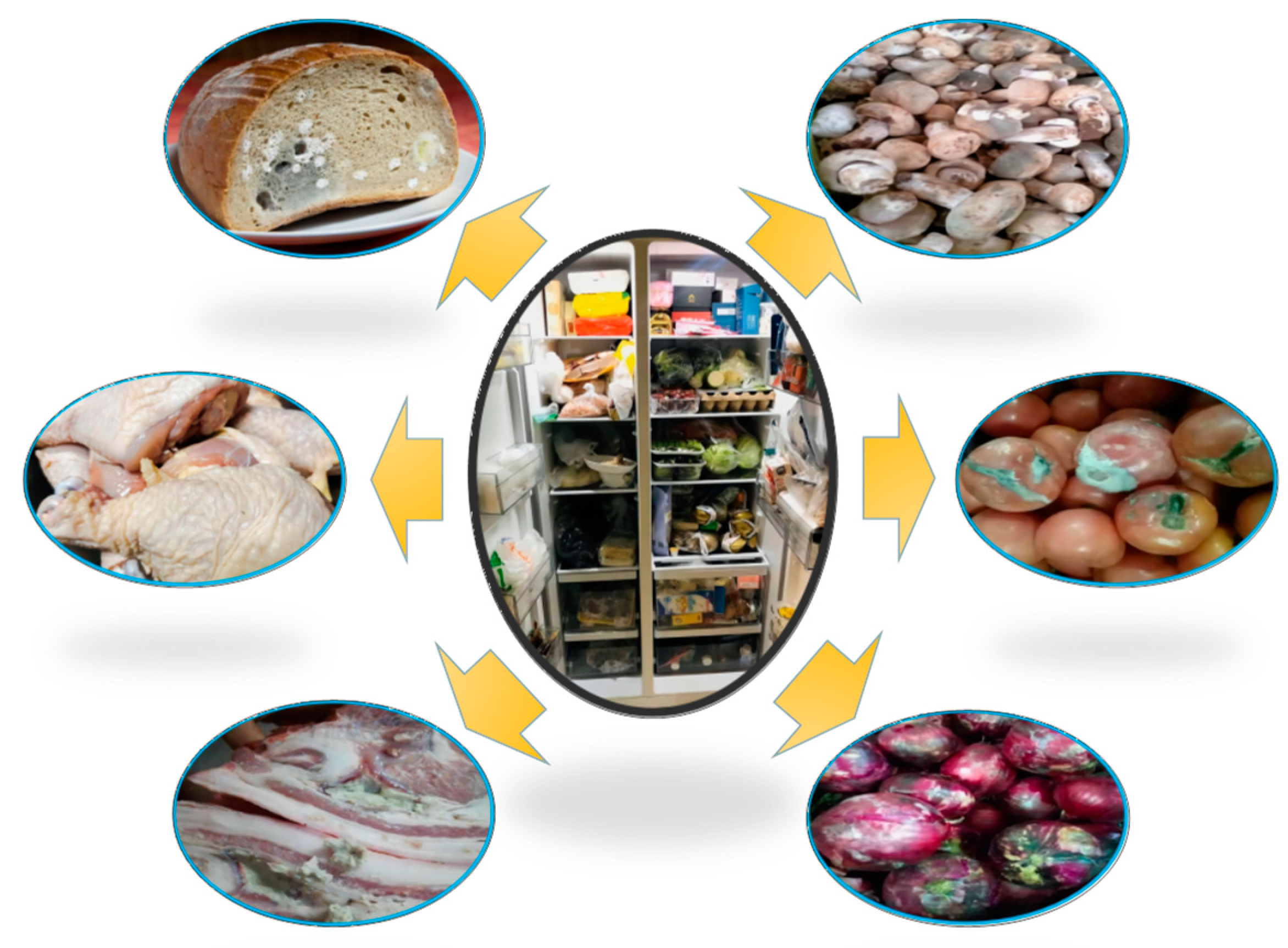
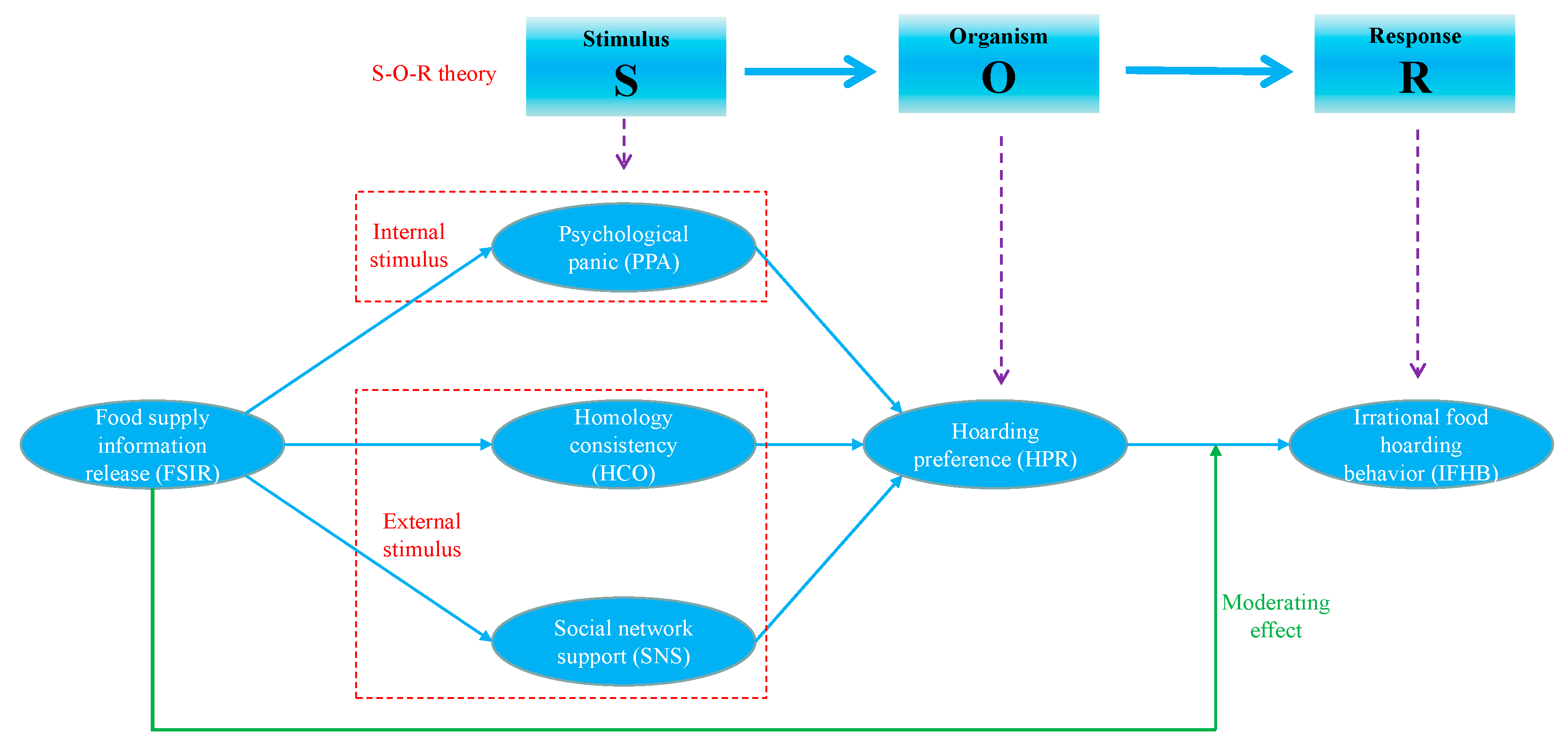
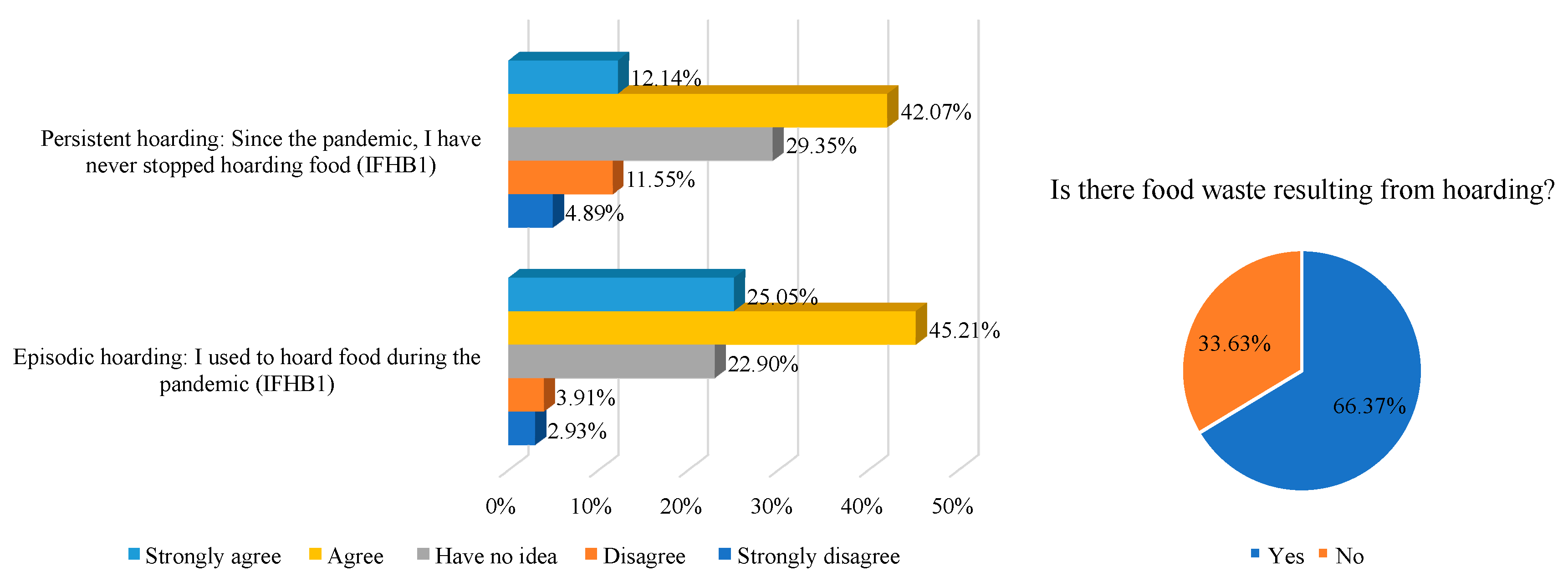
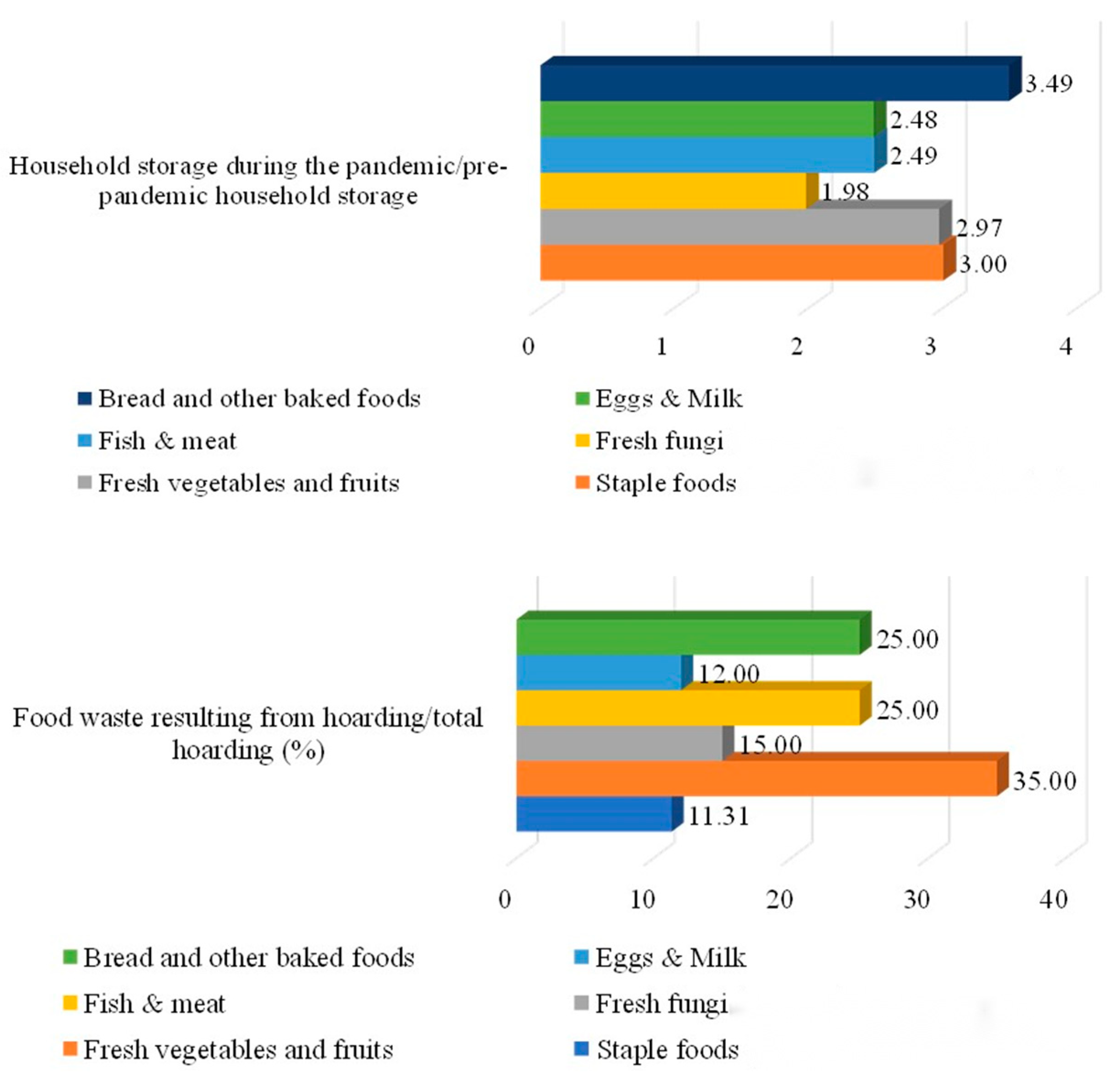



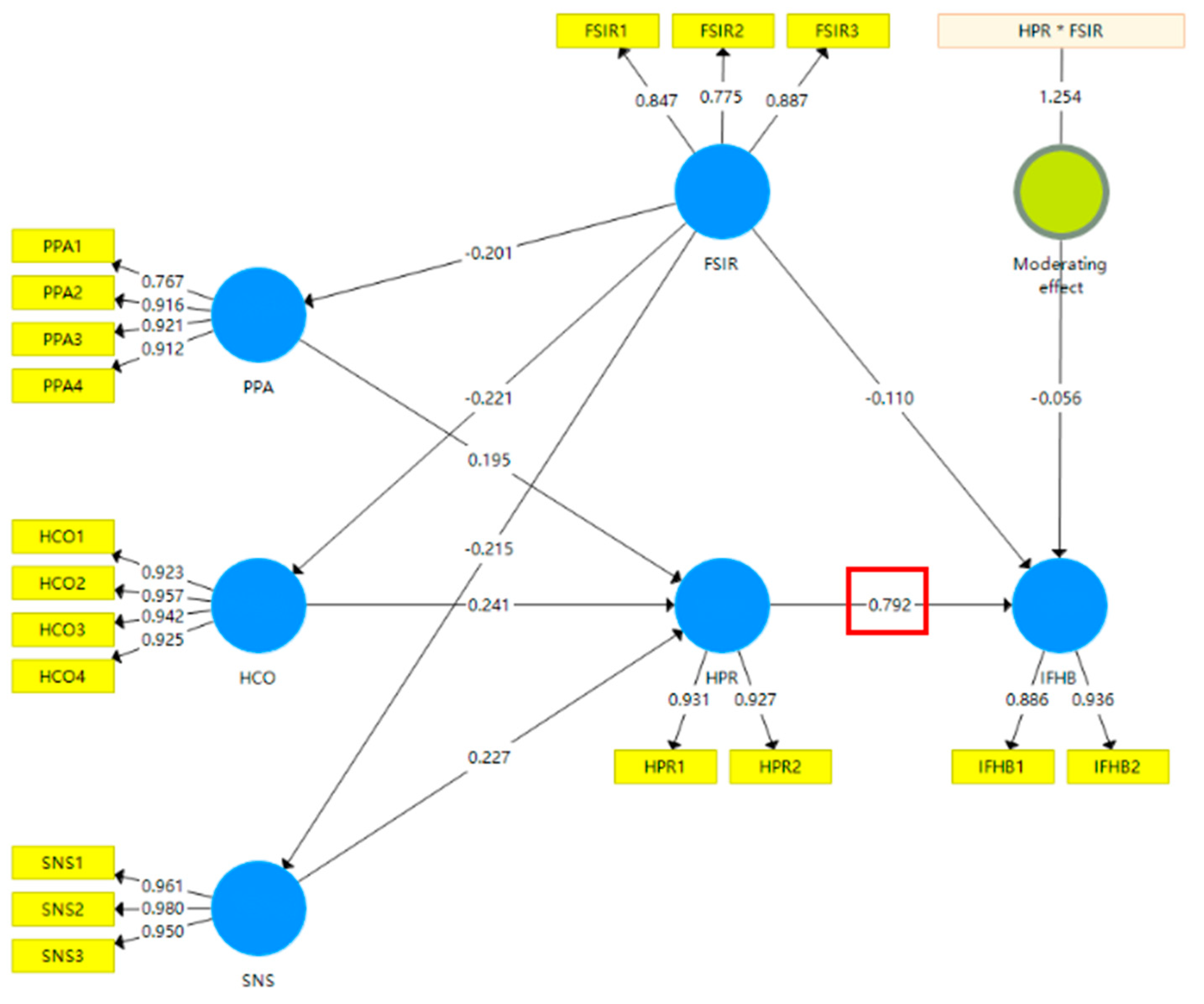
| Variable | Description | Frequency | Ratio (%) |
|---|---|---|---|
| Gender | Male | 333 | 65.17 |
| Female | 178 | 34.83 | |
| Age | 30 years old and below | 196 | 38.35 |
| 31–40 years old | 186 | 36.40 | |
| 41–50 years old | 91 | 17.81 | |
| Over 50 years old | 38 | 7.44 | |
| Highest education completed (Education1) | High school and below | 39 | 7.63 |
| (Education2) | Professional training or bachelor’s degree | 261 | 51.08 |
| (Education3) | Master’s degree and above | 211 | 41.29 |
| Marital status | 1 = married | 341 | 66.73 |
| Household size | Less than 3 | 143 | 27.98 |
| 3–4 | 268 | 52.45 | |
| More than 4 | 100 | 19.57 | |
| Monthly household income | Less than CNY 10,000 | 115 | 22.50 |
| CNY 10,000–19,999 | 205 | 40.12 | |
| CNY 20,000–29,999 | 80 | 15.66 | |
| CNY 30,000 and above | 111 | 21.72 | |
| Monthly household food expenditure | CNY 2000 and below | 218 | 42.66 |
| CNY 2001–4000 | 173 | 33.86 | |
| Over CNY 4000 | 120 | 23.48 |
| Variable | Item | References |
|---|---|---|
| Psychological panic (PPA) | Boughton et al. [30] | |
| PPA1 | I often feel less well now compared to before the pandemic. | |
| PPA2 | I often feel more nervous now compared to before the pandemic. | |
| PPA3 | I often feel more anxious now compared to before the pandemic. | |
| PPA4 | I often feel more upset now compared to before the pandemic. | |
| Homology consistency (HCO) | Raaij [49] | |
| HCO1 | When I see others hoarding food, I take it for granted that hoarding food is important. | |
| HCO2 | When I see others hoarding food, I take it for granted that hoarding food is necessary. | |
| HCO3 | When I see others hoarding food, I take it for granted that hoarding food is urgent. | |
| HCO4 | When I see others hoarding food, I take it for granted that hoarding food is a wise choice. | |
| Social network support (SNS) | Li et al. [50] | |
| SNS1 | Relatives advised me to hoard food to address the potential risks of the pandemic. | |
| SNS2 | Friends advised me to hoard food to address the potential risks of the pandemic. | |
| SNS3 | Neighbors advised me to hoard food to address the potential risks of the pandemic. | |
| Hoarding preference (HPR) | Day et al. [51]; Becker et al. [52] | |
| HPR1 | I am more inclined to hoard food now than I was before the pandemic. | |
| HPR2 | As long as the pandemic does not end, my food-hoarding tendencies will not abate. | |
| Irrational food hoarding behavior (IFHB) | Si et al. [53]; Wang et al. [54] | |
| IFHB1 | Episodic hoarding: I used to hoard food in large quantities during the pandemic. | |
| IFHB2 | Persistent hoarding: since the pandemic, I have not stopped hoarding food in large quantities. | |
| Food supply information release (FSIR) | Li et al. [44] | |
| FSIR1 | The government’s food supply information release system is perfect. | |
| FSIR2 | Government information release on food supply is always timely. | |
| FSIR3 | Food supply information released by the government is reliable. |
| Item | Mean | S.D. | Factor Loading | Cronbach’s α | CR | AVE |
|---|---|---|---|---|---|---|
| PPA1 | 2.239 | 0.923 | 0.762 | 0.902 | 0.933 | 0.777 |
| PPA2 | 2.695 | 1.058 | 0.916 | |||
| PPA3 | 2.767 | 1.104 | 0.923 | |||
| PPA4 | 2.734 | 1.044 | 0.915 | |||
| HCO1 | 3.387 | 0.896 | 0.923 | 0.954 | 0.966 | 0.878 |
| HCO2 | 3.399 | 0.899 | 0.957 | |||
| HCO3 | 3.282 | 0.896 | 0.942 | |||
| HCO4 | 3.339 | 0.895 | 0.925 | |||
| SNS1 | 3.550 | 0.827 | 0.961 | 0.962 | 0.975 | 0.929 |
| SNS2 | 3.501 | 0.823 | 0.980 | |||
| SNS3 | 3.448 | 0.826 | 0.950 | |||
| HPR1 | 3.386 | 0.985 | 0.931 | 0.842 | 0.927 | 0.863 |
| HPR2 | 3.487 | 0.986 | 0.927 | |||
| FSIR1 | 3.740 | 0.800 | 0.845 | 0.787 | 0.874 | 0.699 |
| FSIR2 | 3.732 | 0.857 | 0.753 | |||
| FSIR3 | 3.871 | 0.823 | 0.905 | |||
| IFHB1 | 3.450 | 1.008 | 0.886 | 0.799 | 0.907 | 0.830 |
| IFHB2 | 3.855 | 0.939 | 0.936 |
| Fornell–Larcker Criterion 1: | ||||||
|---|---|---|---|---|---|---|
| PPA | HCO | SNS | HPR | FSIR | IFHB | |
| PPA | 0.882 | |||||
| HCO | 0.357 | 0.937 | ||||
| SNS | 0.307 | 0.781 | 0.964 | |||
| HPR | 0.351 | 0.488 | 0.475 | 0.929 | ||
| FSIR | −0.200 | −0.220 | −0.213 | −0.312 | 0.836 | |
| IFHB | 0.352 | 0.441 | 0.466 | 0.830 | −0.335 | 0.911 |
| HTMT ratio 2: | ||||||
| PPA | HCO | SNS | HPR | FSIR | IFHB | |
| PPA | ||||||
| HCO | 0.385 | |||||
| SNS | 0.329 | 0.816 | ||||
| HPR | 0.401 | 0.542 | 0.523 | |||
| FSIR | 0.237 | 0.254 | 0.243 | 0.371 | ||
| IFHB | 0.415 | 0.500 | 0.528 | 0.795 | 0.404 | |
| Index | Recommended Level | Estimate Value | GOF |
|---|---|---|---|
| χ2/df | <2.0 | 0.065 | Yes |
| RMR | <0.05 | 0.037 | Yes |
| RMSEA | <0.05 | 0.019 | Yes |
| GFI | >0.9 | 0.932 | Yes |
| AGFI | >0.9 | 0.985 | Yes |
| NFI | >0.9 | 0.917 | Yes |
| IFI | >0.9 | 0.964 | Yes |
| PPA | HCO | SNS | HPR | |
|---|---|---|---|---|
| HPR | 0.351 ** | 0.488 *** | 0.475 *** | |
| IFHB | 0.830 *** |
| Without Moderating Effect | With Moderating Effect | |||
|---|---|---|---|---|
| HPR | R2 | 0.490 | R2 | 0.559 |
| Q2 | 0.212 | Q2 | 0.243 | |
| IFHB | R2 | 0.688 | R2 | 0.697 |
| Q2 | 0.155 | Q2 | 0.290 | |
| Path | Estimate | p | Hypothesis | Supported |
|---|---|---|---|---|
| PPA -> HPR | 0.195 | *** | H1 | YES |
| HCO -> HPR | 0.241 | ** | H2 | YES |
| SNS -> HPR | 0.227 | ** | H2 | YES |
| FSIR -> PPA | −0.201 | *** | H4 | YES |
| FSIR -> HCO | −0.221 | *** | H4 | YES |
| FSIR -> SNS | −0.215 | *** | H4 | YES |
| HPR -> IFHB | 0.830 | *** | H3 | YES |
| Path | Estimate | p | Hypothesis | Supported |
|---|---|---|---|---|
| Without moderating effect: | ||||
| HPR -> IFHB | 0.830 | *** | H3 | YES |
| With moderating effect: | ||||
| Moderating effect value | −0.056 | ** | H5 | YES |
| HPR -> IFHB | 0.792 | *** |
| Path | Differences in Path Coefficients (High_Exposure-Low_Exposure) | t-Value |High_Exposure vs. Low_Exposure| | p-Value |High_Exposure vs. Low_Exposure| |
|---|---|---|---|
| PPA -> HPR | 0.181 | 1.847 | 0.068 |
| HCO -> HPR | 0.091 | 0.441 | 0.660 |
| SNS -> HPR | 0.431 | 2.196 | 0.130 |
| FSIR -> PPA | 0.251 | 2.211 | 0.029 |
| FSIR -> HCO | 0.243 | 2.256 | 0.026 |
| FSIR -> SNS | 0.313 | 2.991 | 0.003 |
| HPR -> IFHB | 0.040 | 0.484 | 0.630 |
| Moderating effect | 0.027 | 0.245 | 0.007 |
| Variable | HPR | IFHB |
|---|---|---|
| Male | −0.001 (0.086) | −0.004 (0.085) |
| Age | 0.006 ** (0.005) | 0.003 ** (0.005) |
| Education | ||
| High school and below | Omitted | Omitted |
| Professional training or bachelor’s degree | −0.098 * (0.085) | −0.095 (0.084) |
| Master’s degree and above | −0.157 ** (0.169) | −0.183 * (0.166) |
| Marital status | −0.280 (0.116) | −0.138 (0.114) |
| Household size | 0.052 * (0.030) | 0.019 ** (0.029) |
| Monthly household income | −0.002 (0.009) | −0.004 (0.009) |
| Monthly household food expenditure | 0.101 (0.046) | 0.082 (0.046) |
| Constant | 3.671 *** (0.198) | 3.759 *** (0.195) |
Publisher’s Note: MDPI stays neutral with regard to jurisdictional claims in published maps and institutional affiliations. |
© 2022 by the authors. Licensee MDPI, Basel, Switzerland. This article is an open access article distributed under the terms and conditions of the Creative Commons Attribution (CC BY) license (https://creativecommons.org/licenses/by/4.0/).
Share and Cite
Zhang, K.; Li, F.; Li, H.; Yin, C. Sustainable Management of Food Waste during COVID-19 Pandemic: Insights into Irrational Food Hoarding among Chinese Citizens. Foods 2022, 11, 4049. https://doi.org/10.3390/foods11244049
Zhang K, Li F, Li H, Yin C. Sustainable Management of Food Waste during COVID-19 Pandemic: Insights into Irrational Food Hoarding among Chinese Citizens. Foods. 2022; 11(24):4049. https://doi.org/10.3390/foods11244049
Chicago/Turabian StyleZhang, Kangjie, Fuduo Li, Huanli Li, and Changbin Yin. 2022. "Sustainable Management of Food Waste during COVID-19 Pandemic: Insights into Irrational Food Hoarding among Chinese Citizens" Foods 11, no. 24: 4049. https://doi.org/10.3390/foods11244049
APA StyleZhang, K., Li, F., Li, H., & Yin, C. (2022). Sustainable Management of Food Waste during COVID-19 Pandemic: Insights into Irrational Food Hoarding among Chinese Citizens. Foods, 11(24), 4049. https://doi.org/10.3390/foods11244049







